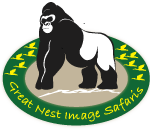The African Jacana | Uganda birding
The African jacana | Uganda birding : is a unique fancy-looking, vaguely chicken-like shore bird of fresh water in the family of jacanas. Jacanas are generally a group of wetland birds, which are identifiable by their elongated feet, toes and claws. These enables them to walk on floating vegetation in the marshes, lakes as well as ponds in tropical lowlands. This specie is also known as the “Jesus bird” since it appears to walk on water. In addition, these lovely birds are also known as “lily walkers or trotters” because of their slender legs and toes. Furthermore, when it flies, the feet trail behind it while on landing. It may also hold the wings high for a moment displaying off the yellow flight feathers whilst making a squawking call.
Physical description
These are generally medium sized wading birds with long legs and extremely elongated toes. Adults are relatively dark overall; they have a black neck, head and breast. The back, undersides, and tail are dark Rufous. In addition, they have a yellow bill with a white base and yellow shield on the forehead. More so, its bill has yellow patches and its forehead has a yellow wattle. Juveniles have a white underside and a darker back, head and neck.
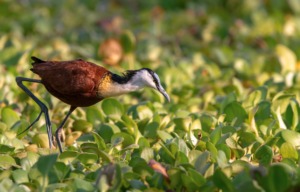 Both adults and juveniles have conspicuous yellow flight feathers that are visible when they raise their wings. The bird’s primary and secondary yellowish-green feathers are visible plus the yellow bony spurs on the leading edge of the wings, used to defend itself and it’s young one. The greenish color of the wing feathers is produced by a pigment called zooprasinin, a copper containing organic compound something rare in birds. The female jacanas are twice as big as the male meaning that males are found to be significantly smaller than females.
Both adults and juveniles have conspicuous yellow flight feathers that are visible when they raise their wings. The bird’s primary and secondary yellowish-green feathers are visible plus the yellow bony spurs on the leading edge of the wings, used to defend itself and it’s young one. The greenish color of the wing feathers is produced by a pigment called zooprasinin, a copper containing organic compound something rare in birds. The female jacanas are twice as big as the male meaning that males are found to be significantly smaller than females.
Behaviours
These birds are highly social and frequently occur in small colonies with a dominant female with 1 to 4 males. They are basically diurnal and spend much of their time walking on emergency vegetation in search for aquatic insects and seeds. They also pick food off the surface of plants, water or just below the water since their feet are highly specialized for this foraging behavior. Their small size and large feet allow these birds exploit this foraging habitat, as they can easily support their weight on aquatic vegetation surfaces.
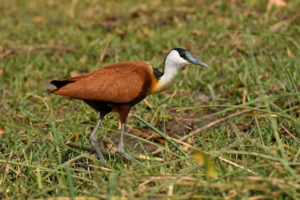 They also forage by walking on top of wetland vegetation, using its incredibly long toes to distribute its weight and stay on top of wetland. Interestingly, if the female loses her territory to another female, then the newcomer will have access to the males in that territory. Purple gallinules are the most common predators of this bird’s offspring and eggs. Due to this reason, they will attack the purple gallinules when they see them in their territories. If threatened, jacana chicks as well as adults stay underwater for long periods with only the tip of their bill above water and can also decide to swim under water in order to avoid predators.
They also forage by walking on top of wetland vegetation, using its incredibly long toes to distribute its weight and stay on top of wetland. Interestingly, if the female loses her territory to another female, then the newcomer will have access to the males in that territory. Purple gallinules are the most common predators of this bird’s offspring and eggs. Due to this reason, they will attack the purple gallinules when they see them in their territories. If threatened, jacana chicks as well as adults stay underwater for long periods with only the tip of their bill above water and can also decide to swim under water in order to avoid predators.
Breeding
The breeding system an African jacanas is not usual and is an example of polyandry birds. Both males and females will defend territories against other members of the same sex. The male generally forms a pair bond with a female who will keep other females out of his territory. These bonds between the males and females last throughout the year even outside. In fact, breeding and can only end incase a male or female is replaced.
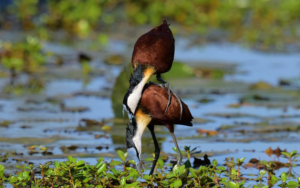 When the female breeds, the male builds platforms that are for solicitation displays, copulation and used as nests as well. In fact, the male may create several nests at different sites and the female may choose one or find a site of her own in the territory. The female or the male may solicit to each other and this behavior leads to copulation. When the female assumes a pre-copulatory position, the male may fly up 10 meters or more before flying back down. It lands on her back or landing alongside and hopping on her back.
When the female breeds, the male builds platforms that are for solicitation displays, copulation and used as nests as well. In fact, the male may create several nests at different sites and the female may choose one or find a site of her own in the territory. The female or the male may solicit to each other and this behavior leads to copulation. When the female assumes a pre-copulatory position, the male may fly up 10 meters or more before flying back down. It lands on her back or landing alongside and hopping on her back.
Reproduction
Four eggs are typically laid per clutch with black markings and the male typically sits on the eggs. The male incubates the eggs whilst the female may visit the nest site occasionally to squat and shade the eggs but not incubating and eggs hatch in around 28 days. The male continues to incubate the remaining eggs while brooding the hatched chicks. When all the eggs hatched, the male will dispose off the remaining egg shells. The young leave the nest around 24 hours after hatching and will follow the male to good foraging spots. Chicks are able to dive, swim and feed shortly after they hatch.
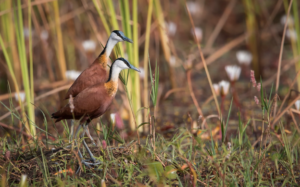 Males are intolerant of intruders in their territory and make calls to the female for help for predator defense. Females respond to each every call the male makes and invests much interest in the safety of the chicks, despite having little interaction with them. The females will then provide the males with a new clutch when the chicks are 12-16 weeks old. Because females may have several mates, some or all of the young that he raises may not be his.
Males are intolerant of intruders in their territory and make calls to the female for help for predator defense. Females respond to each every call the male makes and invests much interest in the safety of the chicks, despite having little interaction with them. The females will then provide the males with a new clutch when the chicks are 12-16 weeks old. Because females may have several mates, some or all of the young that he raises may not be his.
Vocalization
Northern jacanas communicate with visual displays and calls and repeated-call notes are given in a number of situations. Jacanas will emit “clustered-call notes”, which are made of individual notes clustered together when they attack intruders in their territories. They also communicate by uttering a number of notes whereby males also make calls when his chicks or eggs are under threat by predators. Threat displays are given by outstretching the wings and pointing them forward.
Males may do a submissive display in the presence of females in which they crouch down. During the submissive display the males swing their heads laterally while the females peck at the base of the male’s neck. In addition, also during flight, the bird will be heard uttering an abrasive squawking call. Calls are also made when a female is away from the territory for too long or even when a male cannot find a chick.
Feeding
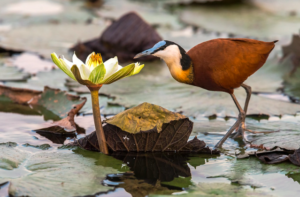 In feeding, these birds compete with birds of a similar diet like the sora. They basically feed on whatever insects they can glean off of aquatic plants and surfaces. Jacanas turn over floating plants using their bills and feet while searching for insects hiding on the under-surface. These birds also nourish on flowers that are opened by purple gallinules. In conclusion, northern jacanas feed on insects, snails, worms, small crabs, mollusks, seeds and ovules of water lilies.
In feeding, these birds compete with birds of a similar diet like the sora. They basically feed on whatever insects they can glean off of aquatic plants and surfaces. Jacanas turn over floating plants using their bills and feet while searching for insects hiding on the under-surface. These birds also nourish on flowers that are opened by purple gallinules. In conclusion, northern jacanas feed on insects, snails, worms, small crabs, mollusks, seeds and ovules of water lilies.
Where to spot African Jacanas in Uganda
In Uganda, you can find these bird species in Mabamba swamp, Kidepo Valley National Park and Murchison Falls National Park. They also inhabit many types of wetlands including; marshes, ponds as well as lake margins. They occasionally favor pond edges with abundant floating vegetation and forage in wet grassy areas and flooded fields.
